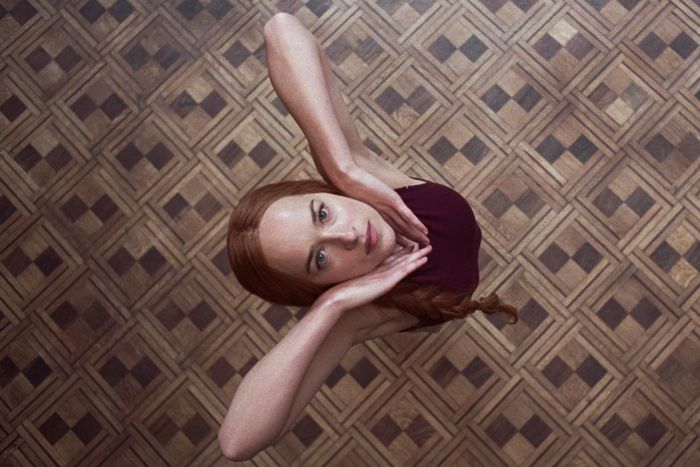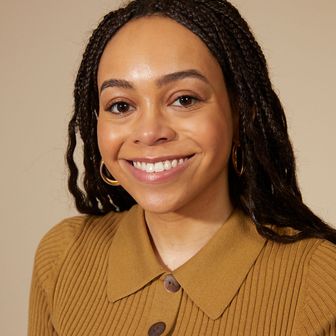
Screenwriter David Kajganich hasn’t quite figured out what to call the kind of scripts he writes. Luca Guadagnino’s summery, murderous A Bigger Splash; the bloody, murderous Suspiria; a script for It that the studio didn’t end up using; 2007’s The Invasion — these are movies are based on older movies, but calling them “remakes” doesn’t feel precise either. “We’ve called them a lot of things. I don’t think of them as remakes,” he told Vulture over the phone. “I still haven’t figured out the right word for what Luca and I have done in [A Bigger Splash and Suspiria], but I think the method has been the same in both cases, which is to isolate the minimal things from the original that feel to us like they are still organically of interest today, and then kind of rebuild a world around them and reimagine the psychologies of the characters within them, in a way that speaks to things that we are having conversations about right now.”
For Suspiria, it came down to thinking about the coven of witches as practical beings, beholden to the same dramatic schisms and personality clashes of any other group. Instead of devoting to time to building the mystery of “are they or aren’t they,” the new Suspiria clears that hurdle immediately. “We got rid of that question — are they or aren’t they witches — in the first ten minutes of the film,” Kajganich said. “We didn’t want to hang the mystery of our film on the same question as Argento’s. We thought anyone who knows about the original Suspiria is going to know it’s about a coven, so we needed to go much further into the politics of it.” Kajganich talked to Vulture about radically reimagining Dario Argento’s original. (Beware ending spoilers in the last two questions!)
Your Suspiria keeps the witches and the dancing from the original, but adds this deeper psychological element. It’s more curious about feminism, postwar guilt, and the rise of leftists in Germany. What intrigued you about that?
As soon as we understood that we wanted to set the film in ’77, which was the year that Argento’s film came out, it seemed very obvious to us that one way we could bring something new to the table was to allow the outside world a place at the table. Argento’s Suspiria is this incredible fever dream, but it feels really hermetically sealed — the outside world doesn’t really come in at all. When we started to think about this coven of witches in a practical way, figuring out, What did they want, how would they go about having the influence they want to on the world? It just seemed like this moment in time would have been particularly transformative to the coven. Berlin and Germany in ’77 was in a kind of youth revolt, where the young generation was sort of forcing the older generations to take responsibility for how they’d been implicated in the events of the war. I think, from a coven’s point of view, they could see the massive opportunity to insert their influence in all the cracks that were being created by all of that open hostility.
And so, thinking practically about this coven, how did you see that manifest?
They needed to get their house in order. They have to remove their own kind of politics inside of the coven, and they have to decide their political outlook. Are they going to follow their current leader into the future, or are they going to follow a different leader into the future? The politics inside of this coven were of great interest to me and Luca when we were discussing the project, because we thought that that would be a much more interesting, new way to think about Suspiria, as opposed to simply wondering whether the company was a coven at all.
Did Luca just text you saying, “I want to make a new Suspiria”?
I knew he had a deep relationship with the original film. He’d been a part of trying to remake it in the past with David Gordon Green, so I knew it was on his radar. When we were on location shooting A Bigger Splash he sat me down and said, “Look, I think I want to do this myself. Would you be interested in writing it?”
We immediately started to talk about what his relationship to the original was, but also, different ways we could unpack it so that it wasn’t a strict re-creation of that same story. It was a benefit that Luca was quite obsessed with the original, and that I was quite confused by the original. If both of us had been slavish fans to the original, it wouldn’t have worked.
Can you tell me more about your relationship to the original?
Like everyone who sees it, it sort of blows you away in the sense that it is an assault on your senses. It made me feel like I’d been dragged into a lava lamp by a lunatic and stabbed to death. It’s quite an experience. That said, I have pretty practical point of view about storytelling, and so when I don’t understand things like rooms full of barbed wire without any explanation, it doesn’t scare me as much as I sit there thinking, like, Why would someone have a room full of barbed wire in their school? So, it lost me in a way that I think a lot of people don’t mind.
I’m thinking that adapting an older movie has a different set of challenges than adapting a novel. When you’re writing these scripts, how often do you return to the original film?
With the original Suspiria, so much of one’s experience in watching it is about how it’s shot, its palette, you know, the production values, the score. None of those things was going to be useful to me writing these screenplays. I’d seen it once as a teenager, then I watched it once more after Luca and I had our initial conversation. That time, I took lots of notes about the structure and the characters. And then I didn’t watch it again. I traded it for research I was doing in Berlin at the time, about the war, feminist ideology and feminist politics at the time, feminist art at the time, dance. I spent my time researching those things, as opposed to being overly slavish to the original. I let it go pretty early in my process.
It feels like A Bigger Splash is still in conversation with the original, La Piscine, even when it contrasts.
La Piscine was little bit different. We talked a lot about subverting the structure of La Piscine. It required going back a little more to the original, just to balance out the structure of it. But still, I wouldn’t say we spent a lot time, or that I spent a lot of time, watching the original. Actually, Luca and I tried to watch it together and we couldn’t get the sound to work on the television, so we watched most of it without sound, which was interesting, and then we let it go. So, I spent a little bit more time looking back on that film, but not much.
There’s one Suspiria scene that I’m really curious about: Investigators come into the dance school, and they’re sort of bewitched by the women. They’re stripped naked and the women laugh at them. It was one of the boldest images in the movie. How did you arrive at that?
Now that Tilda’s admitted to having played Dr. Klemperer, those are really the only two men in the film. And it was important to the philosophy of the film to show these men walk into this company thinking that they are going to do a day’s work, but within seconds they’re mesmerized by the witches. They are toyed with and played with, and then released without any memory of what’s happened. More than anything, we wanted an audience to feel that the way that this company and these women are going to wield their power was not going to be predictable. Is this a kind of harmless game they’re playing in that kind of scene, or does it speak to something much deeper? It’s hard to tell, it’s ambiguous.
Because it’s a horror film, we really wanted an audience to not always know how they were meant to feel about what they were seeing. It’s the same as the scene at the end where Susie wipes Klemperer’s memory at the end. Is an audience meant to think that that’s a gift to Klemperer, or is the audience meant to think that that’s some kind of theft? You could think of it as either. We didn’t want to be super prescriptive about how an audience felt. But with the investigators, we just wanted you to sit with the idea that just because they’re detectives, just because they’re men, doesn’t necessarily mean they’re in charge in this film. In fact, they’re very much not in charge.
Can you tell me how you felt the first time you saw a cut of the Suspiria you made with Luca?
I spent a fair bit of time in the editing room, so I’d seen a lot of cuts, well before the visual effects were in and when the structure was a bit different. But Luca showed me the final ritual at the end of the film with all of the visual effects in it in a sushi restaurant, in the middle of dinner. I was so overwhelmed by what I was seeing! It was on his little iPhone. I couldn’t stop laughing, and people all over the restaurant were looking to try to figure out what was going on at our table. I was just so freaked out and delighted by how it looked when all of the visual effects were in. I couldn’t believe it. I couldn’t believe he went that far.
This interview has been edited and condensed for clarity.


